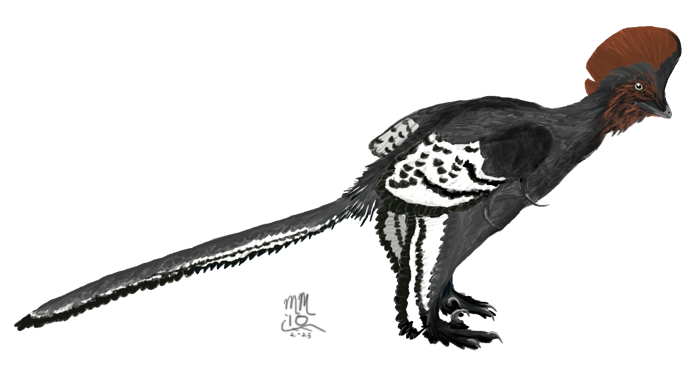home > natural history
Anchiornis huxleyi
"Huxley's near bird"

Anchiornis was first announced at the end of 2008 based on a single, incomplete specimen that didn't really tell us much about the animal save for a few general points: it was very bird-like, with long arms that probably supported wings, and that it was very small. In fact, at only 50 centimetres long including tail and about 120 grams in weight based on adult specimens, Anchiornis remains the smallest known non-avialan dinosaur (as if that distinction means anything anymore!). Reports surfaced online soon after this initial description that more, and better, specimens were known. The first of these was described in September of 2009, and helped to revolutionize the way we look at the evolution of birds.
The second Anchiornis specimen gave us a dazzlingly comprehensive look at the complete animal, from the tip of its surprisingly troodontid snout (it was at first thought to be more closely related to modern birds) to its feathered toes (a first for any Mesozoic bird). Most surprising of all, this specimen revealed that Anchiornis bore flight feathers on the hind legs, similar to tohse found in the dromaeosaur Microraptor. The presence of this trait in two distinct clades close to the origin of birds (plus a third in the form of Pedopenna) helped confirm the hypothesis first proposed by Beebe in the early 1900s: that the first birds flew with four wings, a "tetrapteryx" stage in the evolution of flight. Despite the discovery of Microraptor, some scientists had continued to doubt this was the case, suggesting that the tetrapteryx design arose only in a curious side-branch (the microraptorinae) of early birds. They pointed to dromaeosaurs more primitive than Microraptor (such as Mahakala and Tianyuraptor) as well as primitive troodontids, all of which had short arms unsuitable for any gliding activity at all, to argue that Microraptor aquired long arms and aerial abilities independently from the lineage leading to modern birds. With the discovery of Anchiornis, it's clear that the short-armed dromaeosaurs and troodontids are ground-dwelling descendants of gliding, four-winged ancestors, as are all modern birds.
As in modern flightless birds, more derived dromaeosaurs and troodontids shortened their arms as they lost aerial ability. The beginning of this trend towards loss of gliding can even be seen in Anchiornis itself, which has relatively short wing feathers that are longest in the middle of the wing, unlike flying and gliding species in which the outer feathers are longest. The feathers of Anchiornis also have rounded tips and a central quill that runs right down the middle of the feather, unlike in Microraptor and other flying or gliding birds that have an off-set, or asymmetrical quill to increase lift. The hind wings of Anchiornis are similarly reduced. Like Microraptor, Anchiornis had a tall feathered crest on the head, and very long, dense body feathers, especially noticable along the head and neck, where they hide the neck's distinctive dinosaurian s-curve in favor of a streamlined, very avian profile. The function of the unusually feathered feet is currently unknown.
Image License:
Creative Commons Attribution 3.0
You are free to Share (transmit, copy, and distribute) and to Remix (adapt or modify) the images on this page Under the following conditions: You must Attribute the work by giving written credit to Matt Martyniuk and linking to this Web site: http://www.azhdarcho.com (but not in any way that suggests that they endorse you or your use of the work).
For any reuse or distribution, you must make clear to others the license terms of this work. The best way to do this is with a link to this web page.Any of the above conditions can be waived if you get permission from the copyright holder. Nothing in this license impairs or restricts the author's moral rights.
DESCRIPTION
Length: 50cm (1ft 8in)
Weight: 120g (4.2oz)
Location: Tiaojishan Formation, Liaoning, China
Time: Oxfordian age, Upper Jurassic, (155 Ma)
CLASSIFICATION
Kingdom: Animalia
Phylum: Chordata
Class: Stem-Aves
Family: Troodontidae
Genus: Anchiornis
Species: A. huxleyi
SYSTEMATICS
Sauropsida
Diapsida
Archosauria
Ornithosuchia
Dinosauria
Theropoda
Coelurosauria
Maniraptora
Troodontidae
